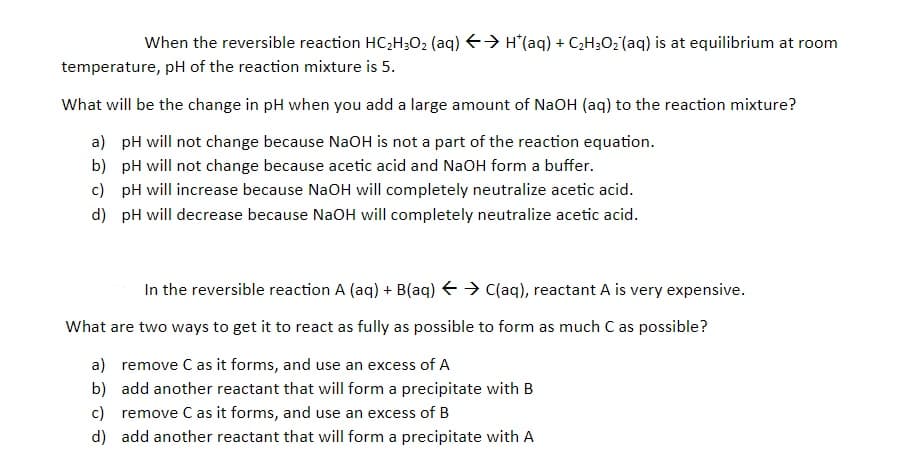When the reversible reaction HC;H;0, (aq) > H'(aq) + C;H;O2(aq) is at equilibrium at room temperature, pH of the reaction mixture is 5. What will be the change in pH when you add a large amount of NaOH (aq) to the reaction mixture? a) pH will not change because NaOH is not a part of the reaction equation. b) pH will not change because acetic acid and NaOH form a buffer. c) pH will increase because NaOH will completely neutralize acetic acid. d) pH will decrease because NaOH will completely neutralize acetic acid. In the reversible reaction A (aq) + B(aq) + → C(aq), reactant A is very expensive. What are two ways to get it to react as fully as possible to form as much C as possible? a) remove C as it forms, and use an excess of A b) add another reactant that will form a precipitate with B c) remove C as it forms, and use an excess of B d) add another reactant that will form a precipitate with A
When the reversible reaction HC;H;0, (aq) > H'(aq) + C;H;O2(aq) is at equilibrium at room temperature, pH of the reaction mixture is 5. What will be the change in pH when you add a large amount of NaOH (aq) to the reaction mixture? a) pH will not change because NaOH is not a part of the reaction equation. b) pH will not change because acetic acid and NaOH form a buffer. c) pH will increase because NaOH will completely neutralize acetic acid. d) pH will decrease because NaOH will completely neutralize acetic acid. In the reversible reaction A (aq) + B(aq) + → C(aq), reactant A is very expensive. What are two ways to get it to react as fully as possible to form as much C as possible? a) remove C as it forms, and use an excess of A b) add another reactant that will form a precipitate with B c) remove C as it forms, and use an excess of B d) add another reactant that will form a precipitate with A
Chemistry & Chemical Reactivity
10th Edition
ISBN:9781337399074
Author:John C. Kotz, Paul M. Treichel, John Townsend, David Treichel
Publisher:John C. Kotz, Paul M. Treichel, John Townsend, David Treichel
Chapter18: Principles Of Chemical Reactivity: Entropy And Free Energy
Section: Chapter Questions
Problem 44PS
Related questions
Question

Transcribed Image Text:When the reversible reaction HC2H;O2 (aq) E> H(aq) + C2H3O2 (aq) is at equilibrium at room
temperature, pH of the reaction mixture is 5.
What will be the change in pH when you add a large amount of NaOH (aq) to the reaction mixture?
a) pH will not change because NaOH is not a part of the reaction equation.
b) pH will not change because acetic acid and NaOH form a buffer.
c) pH will increase because NaOH will completely neutralize acetic acid.
d) pH will decrease because NaOH will completely neutralize acetic acid.
In the reversible reaction A (aq) + B(aq) E > C(aq), reactant A is very expensive.
What are two ways to get it to react as fully as possible to form as much C as possible?
a) remove C as it forms, and use an excess of A
b) add another reactant that will form a precipitate with B
c) remove C as it forms, and use an excess of B
d) add another reactant that will form a precipitate with A
Expert Solution
This question has been solved!
Explore an expertly crafted, step-by-step solution for a thorough understanding of key concepts.
This is a popular solution!
Trending now
This is a popular solution!
Step by step
Solved in 3 steps

Recommended textbooks for you

Chemistry & Chemical Reactivity
Chemistry
ISBN:
9781337399074
Author:
John C. Kotz, Paul M. Treichel, John Townsend, David Treichel
Publisher:
Cengage Learning

Chemistry & Chemical Reactivity
Chemistry
ISBN:
9781337399074
Author:
John C. Kotz, Paul M. Treichel, John Townsend, David Treichel
Publisher:
Cengage Learning